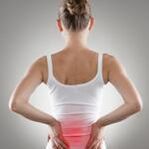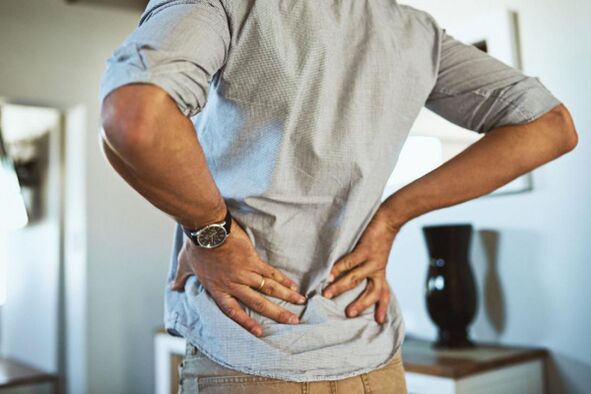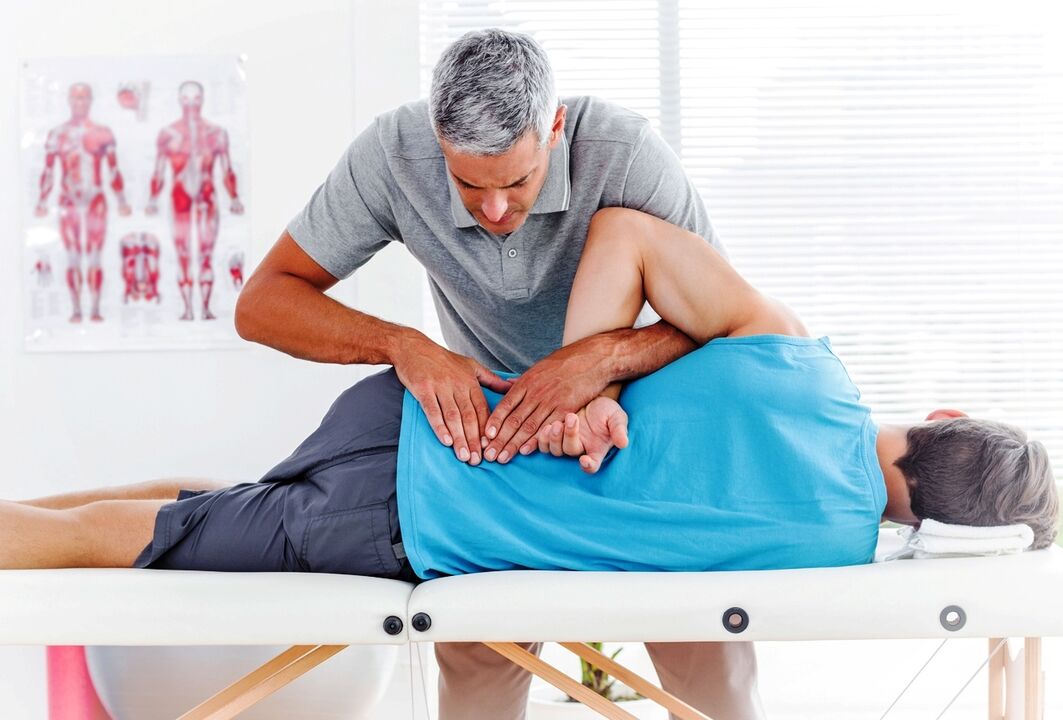
Low painDemonstrates disease or damage to the spinal column, nerve structure, soft tissue, internal organs, observed by the condition of various genesis fever.It is acute, stupid, fixed, periodically, burning, shooting, breaking.Sometimes it is associated with physical activity, weather changes.Pathology, indicated by back pain, is diagnosed on the basis of complaints, anamnesis, examination data and additional studies: radiography, MRI, CT.Before making a diagnosis, peace is required, sometimes allowed to use ointment, take analgesics.
Why the lower back is sick
Spinal disease
The general cause of back pain is congenital anomalies and diseases obtained from the spinal column.The nature of the pain syndrome is different.Pain directly caused by pathological processes, often periodically, local, painful or attractive, associated with weather, physical activity, staying uncomfortable.
Due to muscle cramps, Lumbago (lateral) occurs-sharp pain is accompanied by movement restrictions.With many spinal pathologies, lumboyshialgia is observed - pain, burning or firewood, radiating behind the thighs.Painful sensations are often found in radicular syndrome.Can be detected in the following disease of the spinal column:
- Degenerative pathology: Osteochondrosis, intervertebral disc promotion, intervertebral hernia, spondylosis, spondylo arthrosis.
- Congenital anomalies: Confralization, Libralization.
- The state of polyethiological: Spondylolis, spondylolist.
- Vascular disease: In violation of spinal circulation.
- Another illness: Foreness disease.
- Secondary lesions of the nerve structure: Lumbosacral radiculitis, lumbosacral plexitis, myelopathy of various genesis.

Spinal curvature
Small or moderate pain is observed for all types of spinal column curvature, which is associated with the redistribution of non -Violeology load, muscle overvoltage and back ligaments.Pain arises as a result of uncomfortable body position, sleeping on a bed too hard or too soft.Symptoms are accompanied by:
- Lordosis;
- kyphosis;
- scoliosis;
- kyphoscoliosis;
- Flat rear syndrome.
Osteoporosis
Interesting or painful pain in the lumbar spine and thoracic spine for a long time is the only symptom of osteoporosis.The pain syndrome is clearly stated, increasing after the load, before changing the weather.Symptoms are observed in the following types of osteoporosis:
- postmenopausal;
- Teenagers;
- idiopathic;
- indecent.
The same pain is detected in patients with secondary pathology, due to genetic diseases, endocrine disorders, chronic intoxication, and taking several medications.Secondary osteoporosis can also occur in the background of malabsorption syndrome, liver disease, KHPN, rheumatoid arthritis, well.
Strengthening pain, increasing the duration of pain may be associated with the development of pathological fractures.Other signs of trauma are often not expressed, so fractures are often not diagnosed.
Spinal injury
The most common damage is spinal column bruises.In cases of mild, pathology is characterized by moderate back pain, increasing during movement, local edema, and sometimes hematoma and bleeding.In severe bruises, neurological disorders are added to the symptoms listed.
Lumbar spine compression is caused by a violent body relaxation.It is characterized by sharp pain, holding breathing at the time of injury.Then, an increase in pain in the case of a corps turn was observed, soft tissue edema was detected.The spinous process is painful.Other fractures that may include damage to the arc, horizontal process, spinous process.
In addition, lower back pain is found in patients with traumatic spondylolistisis and vertebral subluxation.The painful sensation is paroxysmal, resembling lumbago, equipped with a feeling of severity and numbness from the lower leg.
Soft tissue and kidney injury
Soft tissue injuries are accompanied by local or moderate local pain quickly, small edema.Bleeding is possible.No blood in urine.Kidney bruises are characterized by pain and short hematuria.In the event of a kidney injury, painful syndrome is intense, pain radiating to the lower abdomen, thighs, and genitals.Hematoma can be seen in the lumbar region.In severe cases, severe pain, prolonged makrohematuria is observed.The state of shock develops.
Spinal and spinal infections
Spinal osteomyelitis can be hematogen, post -traumatic, contact, postoperative.Acute forms of the disease are shown to quickly increase back pain, combined with chills, fever, intoxicated syndrome, and general deterioration.The pain that is wrinkled, broken, so intense that they prevent movement, forcing the patient to freeze on the bed.In chronic osteomyelitis, manifestations are launched, fistulous courses with purulent separated.
Tuberculosis of the spinal column develops gradually.Initially, periodic pain was observed, enhanced after load, increased skin sensitivity in affected vertebra projection.Gait strength is formed.Against the background of the destruction of the bone structure, the nature of the change in pain, as it is caused by the compression of the nerve root.The pain becomes burning, emitting the feet, equipped with paresthesia, numbness.
In patients with spinal epidural abscesses, severe pain, deep, poured, combined with chills, hyperthermia, muscle tension.Recording on the spinous vertebra process is painful.With pathological development, rooster syndrome occurs, then paresis, pelvic organs develop.
The process of local inflammation
The purulent process in surface tissue and fiber near the soil is accompanied by intense back pain.Possible causes of pain syndrome are boils, carbunks and paranephritis.
In the first two cases, the abscess is formed in the skin, looking like a limited and sharp seal with a 1 cm Crimson diameter or a pink shade with one or more stems in the middle.The pain is rapidly, becoming sweating, pulsating, loss of sleep.General hyperthermia, insignificant or moderate violations of the general country are observed.
With paranephritis, the fever was initially mentioned.The pain syndrome develops after 2-3 days.The pain is very intense, can be given to the stomach or hypochondrium, increasing during walking, movement, deep breathing.In several forms of paranephritis due to pain, the patient takes a forced position.The lumbar muscles are tense.Edema, local hyperemia, hyperthermia is detected.His condition is serious.
Contagious
The pain in the lower part, causing the desire to change the body's position, is a feature of acute infection, accompanied by increased temperature and intoxication syndrome.In most cases, they are caused by myositis, often combined with pain in the muscles -the limbs.Observed with influenza, tonsilitis, acute respiratory virus infection.Sometimes the pain is provoked by kidney damage.Infectious diseases accompanied by pain in the lower back area include:
- hemorrhagic fever;
- Japanese mosquito encephalitis;
- Ebola fever;
- foot and mouth disease;
- severe forms of coronavirus infection;
- General forms of bacteria, fungi, viral infections.
In some patients, lower back pain is observed by cytokine - an inflammatory reaction that develops against the background of severe infectious diseases.Epidemiological Myalgia is accompanied by intense paroxysmal pain for up to 10 minutes, which not only appears at the bottom, but also in the other part of the back, in the area of the abdominal wall, chest, limbs.Repeated in 30-60 minutes.Combined with rhinitis, conjunctivitis, severe hyperthermia.
Another muscle lesion
The pain in the muscles -The muscle in the lumbar region is determined after intense physical work -the performance of the strength training for the back muscle, staying long in a forced position with the tense lower back.Myalgia decreases, increases during movement, weakening after heating, warm warm, disappears after a few days.
Myocytes not only develop with infectious diseases, but also after hypothermia or load, against exogenous background, metabolic disorders.Accompanied by long pain.There is also a special form of myositis:
- Infectious myositis specifically for syphilis and tuberculosis;
- Idiopathic, adolescent dermatomyositis and polymiositis;
- Polymiositis and dermatomyositis for oncological pathology, systemic disease of connective tissue.
Chronic pain throughout the body, including the lower back, is observed with fibromyalgia.They are combined with sleep disorders, asthenia, neurotic disorders.
Another illness
In addition to the pathology listed in the bottom, they can interfere with conditions such as:
- Spinal tumor, spinal cord: Sarcoma, hemangioma, metastasis, intramedullary neoplasm and spinal cord extragraul.
- Kidney: Pyelonephritis, glomerulonephritis, urolithiasis, kidney heart attack, renal vein thrombosis, kidney cyst, kidney cancer, purulent process.
- Hereditary: Cerebellar descent ataxia Pierre-Marie.
- Exogenous drunken: Abuse of phenylpropanolamine.
- The pathology of the heart and blood vessels: Leffler endocarditis, stomach aortic aneurysm.
- Emergency: Hemotransfusion shock.
For pelvic disease, the irradiation of pain in the lower back is sometimes observed.The appearance of symptoms is possible with some female diseases, prostate cancer, projection, sigmoid.
Diagnostics
The main diagnostics are performed by orthopedic traumatology.In the presence of neurological symptoms of the patient, neurologists are examining.The doctor interviewed the patient, conducting an objective examination.According to testimony, surgeons, rheumatologists, urologists, and other specialists are appointed.Diagnostic programs may include:
- Neurological examination.In the research process, experts evaluate reflexes, muscle strength, movement coordination, deep and shallow sensitivity.
- X -ray.In the radiography of the lumbar department, bone fractures, decreased intervertebral disc height, other degenerative changes, volumetric formation, signs of inflammation, and spondylolisthesis can be seen.If necessary, standard radiography is equipped with functional studies.
- Other neuroimaging methods.To explain radiographic data, CT and MRI are used.During computed tomography, the solid structure is studied in detail, the condition of the ligaments and the intervertebral disc is checked on the MRI.To exclude stenosis, myelography is performed.
- Functional Research.Muscle conditions and nerve conductivity are evaluated using electromyography, electronography, and potential studies.
- Test.To confirm the infectious nature of the disease, the determination of pathogens makes blood tests and microbiological examinations.To detect neuroinfections, serological reactions are used.

According to testimony, kidney ultrasound, prostate, pelvic organs, urine tests, abdominal aorta, other studies, and other studies were conducted.
Line illness treatment
Help at the prahospital level
With traumatic damage to the spine, it is necessary to place the patient on the shield and immediately send it to the medical institution.If non -human pain, it is necessary to reduce the burden on the back, optimizing the body's position during work and rest.Acute pain syndrome is a clue to consulting a neurologist.
Prior to the expert examination, taking a single analgesic is possible.In Lumbago, lumbar -ilgia caused by degenerative disease previously diagnosed with spinal cord, use of heating and local pain painkillers are allowed.In the event of suspicion of the presence of the infectious process, local funds are not shown.
Conservative therapy
The basis of treatment is physiotherapy and drug therapy.Patients are prescribed a protective regime.Apply the following methods:
- Nsaid.Effective in acute and chronic and spinal muscles.Used in the form of tablets, local products.
- Vitamin neurotropic.Patients are introduced by vitamin B, which improves the effects of other groups, helps reduce pain.
- Local anesthetics.With stubborn and acute pain, an anesthetic blockade is performed.To improve treatment outcomes, painkillers are combined with glucocorticosteroids.
- Physoalization.Apply ultrasound, magnetotherapy, percutaneous electrical stimulation, laser therapy, drug electrophoresis.It is possible to set massage, manual therapy, acupuncture.
Surgical
Given the pathological features, the following surgical intervention is performed:
- Improvement: Inter -core spondylodesis, transpedicular setting, fixing with plates.
- Tumors, osteoporosis, osteomyelitis, tuberculosis: sequestralctomy, vertebroplasty, kyphoplasty, corporate.
- Intervertebral hernia: diskoctomy, microdiscectomy, nucleoplasty.
- Putting the spinal cord: laminectomy, facetectomy, dipping compression of the disc.
In the postoperative period, analgesics, antibiotics are prescribed.Steps -Recovery steps include exercise therapy, massage, physiotherapy.



















